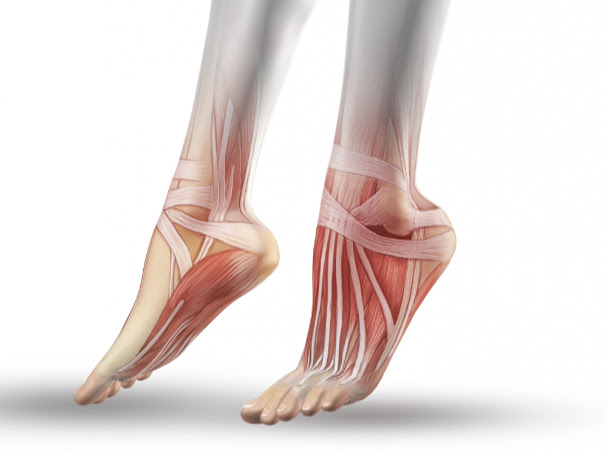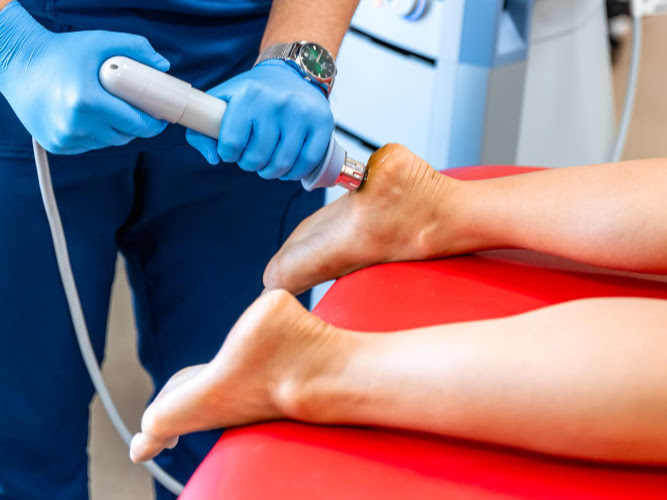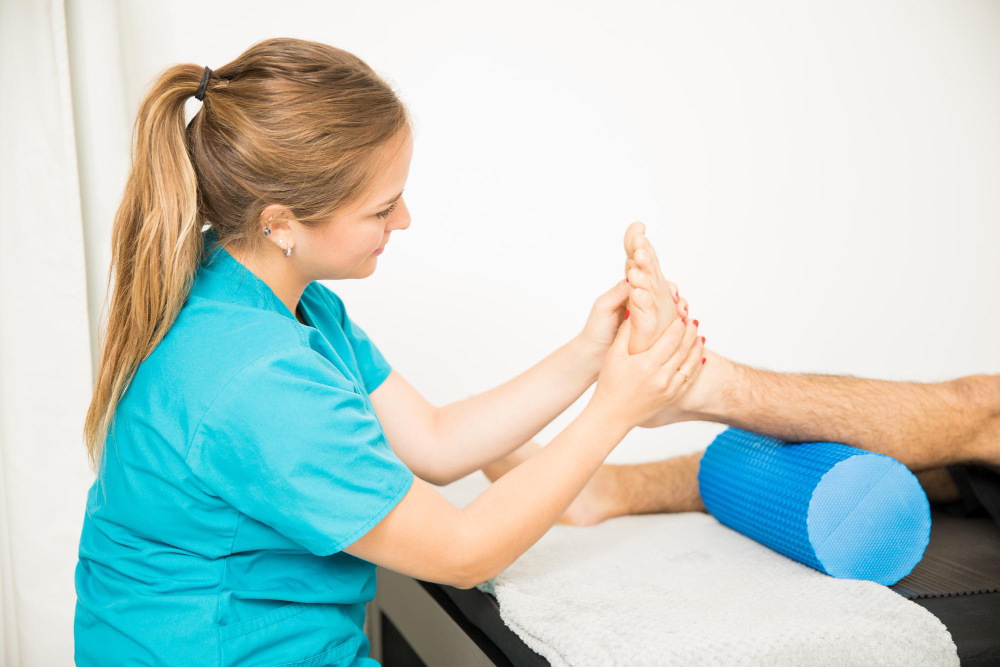Plantar fasciitis is one of the most common causes of heel pain, affecting millions of people around the world. According to a study published in the Journal of Foot and Ankle Research, the prevalence of plantar fasciitis is estimated to be between 3.6% and 7% in the general population (Riel et al., 2017). The plantar fascia is a thick band of connective tissue that runs along the bottom of the foot, connecting the heel bone to the toes. When this fascia becomes inflamed or irritated, it can result in a condition known as plantar fasciitis.
Causes:
- Overuse or repetitive strain on the plantar fascia, such as from excessive running or jumping
- Sudden increase in physical activity levels without proper conditioning
- Biomechanical abnormalities like flat feet, high arches, or abnormal gait patterns
- Obesity or excess weight, which puts additional strain on the plantar fascia
- Aging, as the plantar fascia tends to lose flexibility and become more prone to injury over time
- Certain occupations that involve prolonged standing or walking on hard surfaces
- Tight Achilles tendon or calf muscles, which can contribute to increased tension on the plantar fascia
Symptoms:
- Sharp, stabbing pain in the heel or bottom of the foot, often worse upon taking the first steps in the morning or after periods of inactivity
- Pain that may subside after a few minutes of walking but can worsen as the day progresses
- Increased pain after prolonged standing, walking, or engaging in physical activities
- Stiffness or tightness in the affected foot and heel area
- Swelling or tenderness in the heel or along the plantar fascia
- Difficulty bearing weight on the affected foot or limping due to pain
The pain associated with plantar fasciitis can range from mild discomfort to severe, debilitating pain that can significantly impact daily activities and quality of life. In some cases, the pain may radiate from the heel into the arch or midfoot region.

Effective Treatments for Plantar Fasciitis
- Stretching and Strengthening Exercises:
- Calf stretches: These help to reduce tension in the Achilles tendon and calf muscles, which can contribute to plantar fasciitis. Common stretches include wall calf stretches, stair calf stretches, and seated calf stretches.
- Plantar fascia stretches: Specific stretches target the plantar fascia itself, such as the towel stretch, golf ball roll, and seated plantar fascia stretch. These aim to improve flexibility and reduce strain on the fascia.
- Intrinsic foot muscle strengthening: Exercises like towel curls, marble pickups, and short foot exercises help strengthen the small muscles in the foot, improving stability and support.
- Manual Therapy:
- Deep tissue massage: A physiotherapist may use deep friction massage techniques to break up adhesions and knots in the plantar fascia and calf muscles.
- Myofascial release: This involves applying sustained pressure to the tight fascia and muscles to relieve restrictions and improve mobility.
- Joint mobilization: Gentle movements and techniques are used to improve joint mobility and alignment in the foot and ankle, addressing any biomechanical issues that may contribute to plantar fasciitis.
- Taping or Strapping:
- Low-dye taping: This involves applying rigid sports tape along the arch and plantar fascia to provide support and offload tension.
- Kinesiology taping: Elastic therapeutic tape is applied in specific patterns to facilitate muscle function, improve circulation, and reduce strain on the plantar fascia.
- Extracorporeal Shockwave Therapy (ESWT):
- This non-invasive treatment uses focused shockwaves to stimulate healing and reduce pain in the plantar fascia.
- ESWT is often recommended for chronic cases of plantar fasciitis that haven’t responded to other conservative treatments.
- The shockwaves are thought to promote blood flow, break up scar tissue, and trigger the body’s natural healing processes.
- Ultrasound:
- Ultrasound involves the use of high-frequency sound waves that are transmitted through the skin and into the underlying tissues.
- For plantar fasciitis, ultrasound can be used to deliver deep heating to the plantar fascia and surrounding structures.
- The heat generated by the ultrasound waves can help increase blood flow, reduce inflammation, and promote tissue healing.
- Ultrasound may also help to temporarily relieve pain by decreasing muscle spasms and increasing the extensibility of the plantar fascia and calf muscles.
- Electrical Stimulation:
- Electrical stimulation involves the application of mild electrical currents to the affected area through electrode pads placed on the skin.
- For plantar fasciitis, electrical stimulation can be used to reduce pain and promote healing through various mechanisms.
- Transcutaneous Electrical Nerve Stimulation (TENS) works by interrupting the transmission of pain signals to the brain, providing temporary pain relief.
- Neuromuscular Electrical Stimulation (NMES) can help to improve muscle strength and activation, which can be beneficial for supporting the foot and reducing strain on the plantar fascia.

Self-care Tips for Plantar Fasciitis:
- Use Ice or Cold Therapy:
- Applying ice or cold packs to the heel and arch area can help reduce inflammation and pain associated with plantar fasciitis.
- Cold therapy should be used for 15-20 minutes at a time, several times a day, especially after activity or when the pain is more severe.
- Cold therapy constricts blood vessels, reducing blood flow and swelling in the affected area.
- It also helps to numb pain by decreasing the transmission of pain signals to the brain.
- Care should be taken not to apply ice directly to the skin, and those with poor circulation or sensation should use cold therapy with caution.
- Wear Proper Supportive Footwear:
- Wearing shoes with good arch support and cushioning can help reduce the strain on the plantar fascia and alleviate pain.
- Look for shoes with a deep, reinforced heel cup to support the heel and a rigid shank to prevent overpronation (excessive inward rolling of the foot).
- Replace worn-out shoes regularly, as they lose their supportive properties over time.
- Avoid going barefoot or wearing unsupportive shoes, such as flip-flops or flats, as these can exacerbate plantar fasciitis symptoms.
- Custom-made Orthotics:
- For more severe or chronic cases of plantar fasciitis, custom-made orthotics may be recommended by a podiatrist or physiotherapist.
- These are specialized insoles or foot supports that are molded to the specific contours of your feet.
- Custom orthotics can help correct biomechanical issues, such as overpronation or high arches, that contribute to plantar fascia strain.
- They provide superior arch support, cushioning, and redistribute pressure on the feet more effectively than over-the-counter inserts.
- Night Splints:
- These are lightweight braces or splints worn overnight that gently stretch the plantar fascia and Achilles tendon, preventing excessive tightening during sleep.
- Wearing a night splint can help reduce morning pain and stiffness by maintaining a gentle stretch throughout the night.
- Take Breaks from High-Impact Activities:
- During the healing process, it’s essential to reduce activities that put excessive strain on the plantar fascia.
- Avoid or limit high-impact exercises like running, jumping, or other activities that involve repetitive heel strikes.
- Instead, opt for low-impact activities like swimming, cycling, or elliptical training to maintain fitness while allowing the plantar fascia to rest and recover.
- Listen to your body and take breaks when necessary to avoid further aggravating the condition.
Treat the Plantar Fasciitis From The Physiotherapy Clinic Near You
If you’re suffering from the debilitating pain of plantar fasciitis in Pickering or Milton, Ontario, try Physiotherapy. It offers an effective, non-invasive solution to alleviate your symptoms and get you back on your feet.
At Pro Fusion Rehab, our team of experienced physiotherapists in Pickering and Milton, who are dedicated to providing personalized treatment plans tailored to your specific needs and condition. We understand the unique challenges posed by plantar fasciitis and utilize a comprehensive approach combining stretching exercises, manual therapy techniques, taping or splinting, and advanced modalities like shockwave therapy and custom orthotics.
Don’t let plantar fasciitis keep you from enjoying the activities you love. Take the first step towards a pain-free life by scheduling an appointment with our expert physiotherapists in Pickering and Milton today. Call us today to book your consultation and embark on your journey to recovery.
References:
- Riel, H., Cotchett, M., Delahunt, E., Rathleff, M. S., Vicenzino, B., Weir, A., & Landorf, K. B. (2017). Is ‘plantar heel pain’ a more appropriate term than ‘plantar fasciitis’? Time to move on. British Journal of Sports Medicine, 51(22), 1576-1577. http://dx.doi.org/10.1136/bjsports-2017-097754
- Plantar Fasciitis. (2022, June 25). Mayo Clinic. https://www.mayoclinic.org/diseases-conditions/plantar-fasciitis/symptoms-causes/syc-20354846
- Plantar Fasciitis. (2022, May 24). American Academy of Orthopaedic Surgeons. https://orthoinfo.aaos.org/en/diseases–conditions/plantar-fasciitis
- Tsai, C. T., Chang, W. D., & Lee, J. P. (2010). Effects of short-term treatment with kinesiotaping or foot orthoses on patellofemoral pain syndrome: a randomized controlled trial. Journal of Science and Medicine in Sport, 13(1), 40-45. https://doi.org/10.1016/j.jsams.2009.08.005
- Sweeting, D., Parish, B., Hooper, L., & Chester, R. (2011). The effectiveness of manual stretching in the treatment of plantar heel pain: a systematic review. Journal of Foot and Ankle Research, 4(1), 1-11. https://doi.org/10.1186/1757-1146-4-19
